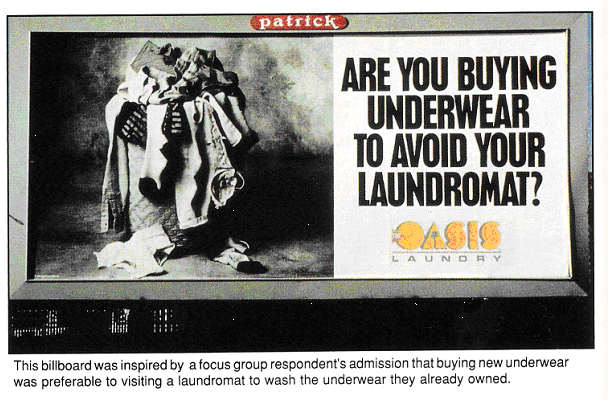A few years ago, when Oasis Laundries co-founder Bill Christensen first started thinking seriously about adding a new wrinkle to the laundromat industry, he did some very basic marketing research. The aspiring entrepreneur visited several Laundromats and asked the customers what they would change to make them better.
They said make them clean, well-lighted places with plenty of working washers and dryers, staff them with an attendant who can help us if we have problems, and give us something to do while we're waiting for our clothes to dry.
"What they described is what an Oasis laundromat is today," Christensen says.
Numerous amenities
Unlike the laundromats most people are used to, Oasis locations boast numerous amenities, including modem decor, an on-duty attendant, projection TV with monitors placed throughout the laundromat showing films on videocassette, current magazines (instead of ancient, dog-eared copies of Popular Mechanics), snack bars, restrooms, and at least one dryer for every washer. Some stores also offer dry cleaning and a drop-off service which will wash, dry and fold clothes.
The first Oasis opened in April of 1987, 10 are now open in the San Jose metropolitan area (five are company-owned, the rest are franchises). By the end of this year, Christensen estimates an additional 20 to 25 locations will have been added.
The industry is fertile ground for such an idea. According to the Coin Laundry Association, 45,000 laundromats in the U.S. make up a $4.5 billion industry serving 20 million people each week.
Ad campaign
Since Christensen's early efforts, the company has continued to use research in many ways. Probably the most visible result of this is an outdoor advertising campaign that arose out of a series of focus groups.
Working with the San Francisco ad agency Mandelbaum Mooney Ashley, Oasis held groups with two target customer types: once-a-week laundromat users and apartment dwellers who didn't use laundromats because their buildings already had facilities.
"We wanted to do some basic learning about how people feel about laundromats," says Don Ashley, partner, Mandelbaum Mooney Ashley. "And we wanted to test some initial hypotheses we had about what might motivate them to use a new kind of laundromat."
They wanted to learn more about the attitudes that each group had about laundromats, and for the apartment dwellers in particular, what features a laundromat would have to have to entice them away from their apartment facilities.
Strong negative perception
Initially, Ashley says, the plan was to tout the many positive features of an Oasis in the advertising. But the focus groups changed that plan. They uncovered such a strong negative perception of laundromats that the decision was made to sell against the negative aspects of regular laundromats.
"The focus groups turned out to be fascinating learning experiences because we found out just how much people really hate laundromats," Ashley says, citing some of the adjectives that focus group participants used to describe laundromats: dirty, crowded, stuffy, unfriendly, and unsafe.

Humorous billboards
These negative perceptions were turned into humorous billboards that poke fun at the horrors of laundromat-going. One shows a row of prison cells with the caption "Most people would rather spend time here than in a laundromat." Another features a shot of an operating room with the caption "It's almost as clean as our laundromats."
The content of a third ad came directly from a focus group respondent who claimed to prefer buying new underwear to visiting a laundromat to wash the underwear they already owned. This inspired a billboard showing a clothes basket overflowing with dirty clothes, bearing the tagline "Are you buying underwear to avoid your laundromat?"
Ashley says that playing off the drawbacks of other laundromats had a significant effect on the success of the advertising.
"The information from the focus groups gave us a course correction prior to doing any advertising that I think made a substantial difference in the results. We knew we had really struck a chord and we really had to play on the negativity of laundromats."

Created a presence
Along with meeting the obvious goal of increasing sales, Christensen says the advertising also created a presence in the San Jose-area market and increased franchise interest.
"It helped in a number of ways. Revenues increased on average between 11 and 20% per store between the first quarter of 1989 and the fourth quarter of 1988.
We got a lot of attention from potential franchisees who became aware of Oasis because they saw a billboard and inquired about the company.
"And it gave us corporate identity and awareness that we really needed because the typical laundromat draws from a very small area, it's a very localized neighborhood-oriented business, so to get any kind of identity is difficult."
Customer surveys
Customer surveys have also been used on an ongoing basis to determine the preferences of each location's customers—for films, magazines, food and beverage choices.
"Those little questionnaires have been of great value to us," says Tanya Roberts, manager, marketing communications, Oasis Laundries. "They're a staple of our whole operating kit. We've seen a huge impact in sales just by changing from muffins to bagels, for example. Something that simple can make a big difference."
The surveys provide information on how much laundry customers do, how they rank the amenities in terms of importance, and they also provide Oasis with an idea of who their customers are.
Roberts says that while there isn't really a typical Oasis customer—everyone from young families to senior citizens are patrons—a large percentage are 18 to 34 year old apartment dwellers. But these profiles will change over time as Oasis adds new services like dry cleaning and drop-off laundry service. Learning more about the users of those new services will be the next research project the company will undertake, she says.
"The drop-off customer is one that we really don't know much about at this point, but through customer surveys and demographic analysis, we should have a clearer picture very soon."
